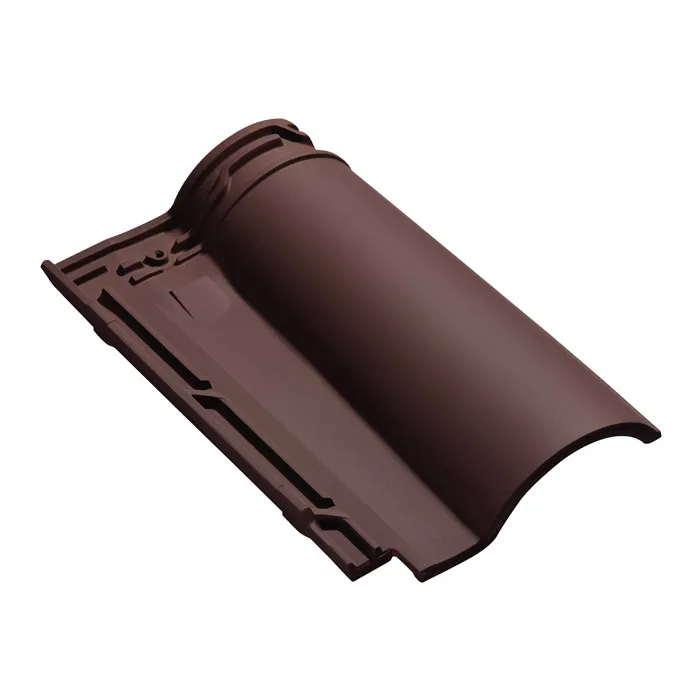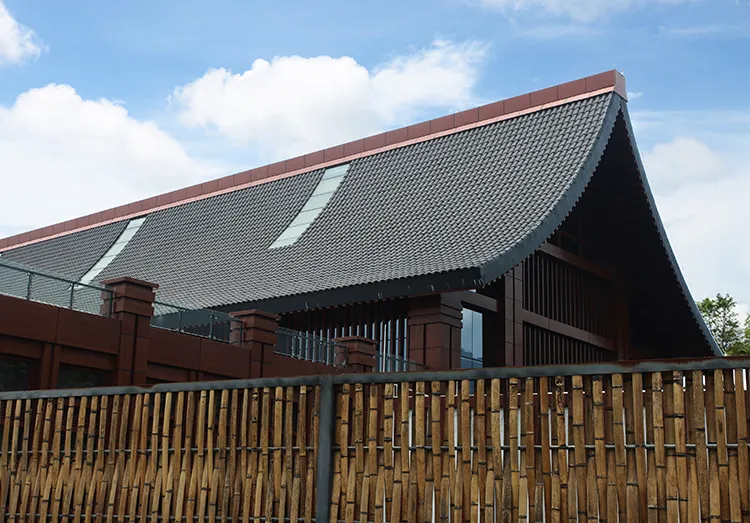Roman clay tiles are favored by the construction industry for their unique historical style, durability and beauty, but because of their high brittleness, they have become one of the "high-risk" materials during maintenance and inspection. Understanding the load-bearing capacity of clay tiles and mastering the skills to walk safely on them is the key to maintaining buildings and ensuring your own safety.
This article will deeply analyze the physical properties, load-bearing capacity of Roman clay tiles, and the key points for walking safely on clay tile roofs.

What is the load-bearing capacity of Roman clay tile roofs?
1. How much weight can Roman clay tiles bear?
The reason why Roman clay tiles can become an ideal roofing material is inseparable from their strong pressure resistance. Under normal circumstances, the density of standard clay tiles is high, and the weight of each tile ranges from 2-5 kilograms. The laid clay tile roof can withstand a certain amount of additional weight. Generally speaking, high-quality clay tiles can withstand a static weight of about 150-200 kilograms per square meter when laid reasonably. This load-bearing capacity is mainly used to resist natural loads such as snow accumulation and falling branches.
However, the load-bearing capacity of clay tiles is not evenly distributed. The edges and corners of the tiles are fragile, while the middle structure is usually stronger. Therefore, you need to pay special attention to the stepping points when walking to avoid the tiles from breaking or being damaged due to improper weight distribution.
2. What factors affect the load-bearing capacity of clay tile roofs?
The load-bearing capacity of clay tiles is affected by many factors, mainly including the thickness, material, laying method of the tiles and the structural strength of the roof. High-quality Roman clay tiles are usually fired at high temperatures and have good compressive resistance; while some low-quality clay tiles are easily broken by external forces due to insufficient material density. In addition, the laying method of tiles also has a significant impact on the load-bearing capacity. The use of staggered and well-fixed tile laying methods can improve the overall compressive resistance of tiles and avoid damage to tiles under uneven force.
The load-bearing capacity of the roof structure is also crucial. If the roof structure is not stable enough or the slope is too large, even high-quality clay tiles will have difficulty maintaining integrity under uneven load. Therefore, when installing and maintaining Roman clay tiles, the roof structure and the load-bearing capacity of the tiles must be considered comprehensively.

What are the risks of walking on Roman clay tiles?
1. Will walking cause clay tiles to break?
When walking on Roman clay tiles, there is indeed a risk of tiles breaking if they are not stepped on properly. Because clay tiles are brittle, especially in alternating hot and cold weather, tiles are prone to microcracks and will break if not paid attention to. Even though the tiles are specially treated during production and have a certain degree of compressive resistance, they are still more fragile under dynamic pressure compared to metal or concrete roofs.
When walking, excessive pressure will act directly on the surface of the tiles. If the weight exceeds the resistance limit of the tiles, it may cause the tiles to break or fall off. In addition, in rainy and snowy weather, the surface of the tiles will become slippery, further increasing the danger of walking. Therefore, if you walk carelessly on a clay tile roof, it is likely that you will not only damage the tiles, but you may also slip or cause an accident.
2. Will broken tiles affect the waterproofness of the roof?
Broken tiles have a significant impact on the waterproofness of the roof. One of the main functions of clay tiles is to isolate rainwater intrusion. When tiles are damaged or displaced, rainwater may directly penetrate into the roof structure, causing the wooden beams and other parts to become damp or even rot. Therefore, once the tiles are accidentally damaged during walking, it may cause the waterproof effect of the roof to decrease and need to be repaired in time.
The roof waterproof layer relies on the sealing and stacking effect between tiles. When tiles are broken or displaced, gaps will form between the tiles, increasing the risk of rainwater intrusion. In addition, broken tiles may cause them to lose their locking points, causing them to slide off in strong winds or heavy rain, further affecting the overall waterproofness of the roof.

How to walk safely on a Roman clay tile roof?
1. Can I step directly on the tiles?
It is very dangerous to step directly on clay tiles. Clay tiles are usually designed in a curved arch shape, with the support points mainly concentrated at the bottom fixing point, while the middle part of the tile is more susceptible to deformation or cracking under pressure. Therefore, stepping directly on the middle part of the tile can easily cause the tile to break, which is not only dangerous but also damages the roof.
In order to avoid stepping directly on the more vulnerable part of the tile, it is recommended to step on the roof beam or joist position. The roof beam is usually the supporting structure of the roof and has a strong load-bearing capacity. Stepping on the joist can disperse the pressure and prevent a single tile from bearing too much weight. If you are not sure about the specific location of the joist, you can consult a construction professional for safe walking guidance.
In addition, if the tiles are arranged more densely, it is recommended to step on the center of each tile. Compared with the edge, the center of the tile usually has better support and is not easy to break. However, you should avoid stepping on the corners of the tile, because the corners are the most vulnerable part of the tile and have a lower bearing capacity.
2. Do you need to wear special equipment for safe walking?
When walking on a clay tile roof, the choice of shoes is crucial. The surface of clay tiles is smooth and slippery. Wearing non-slip shoes can effectively reduce the risk of sliding when walking. Ideal shoes should have good grip performance, and the soles should have patterns to increase friction. In addition, the material of the soles should not be too hard, otherwise it will put more pressure on the tiles.
Avoid wearing shoes with smooth soles such as leather shoes, slippers or high heels. These shoes not only lack sufficient friction, but also easily lose balance on slippery tiles. By choosing the right shoes, the risk of sliding when walking can be effectively reduced and the safety of walking can be ensured.

Does the layout of different tiles affect the way of walking?
1. What is the difference between flat tiles and interlocking tiles?
There are many ways to lay Roman clay tiles, of which flat and interlocking are more common. Flat tiles are relatively fragile, and a single tile has a higher load-bearing requirement, so you should be extra careful when walking. Interlocking tiles are more stable and have a relatively good load-bearing capacity because the tiles support each other, but this does not mean that you can walk at will.
When walking on a roof with interlocking tiles, it is recommended to follow the principle of stepping on the support beam position and avoid stepping too much on the middle of the tile to reduce the pressure on the tile itself. Regardless of the layout, step carefully to avoid unnecessary damage to the tiles and roof structure.
2. Are there different walking techniques for tile roofs at different angles?
Walking techniques for tile roofs at different angles are different. Generally speaking, the greater the angle of the roof, the more difficult it is to walk and the risk of slipping increases. If the roof angle is large, it is recommended to use a ladder or safety rope to assist walking and reduce the frequency of moving on the roof. For flatter roofs, you can walk along the support beam more safely, but you still need to avoid stepping on the middle area of the tile.
On any angle of the roof, you should ensure that you move slowly and steadily, and avoid rapid or large movements to prevent slipping or tile cracking.
How to inspect and maintain clay tile roofs safely?
1. Do you need professionals for roof maintenance?
When walking or performing maintenance work on clay tile roofs, it is usually recommended to ask professional roof maintenance personnel to complete it. Professionals have professional knowledge and skills, and have the necessary safety equipment to effectively reduce risks and ensure the integrity of tiles. Untrained people walking on the roof are often prone to accidents such as broken tiles and slipping injuries.
In addition, professional maintenance personnel can find potential problems with the roof during the inspection process and give timely repair suggestions to avoid leakage, heat loss and other problems caused by damaged tiles, and ensure the long-term use of the roof.
2. What precautions should be taken when checking by yourself?
If there is a need for simple inspection, you can use tools such as high-powered telescopes to observe the condition of the tiles from the ground and try to avoid climbing above the roof. If you must go to the roof, make sure to do it only in dry and windy weather, and avoid going to the roof in rainy and snowy weather to increase the risk of slipping. In addition, you should move gradually during the inspection, and do not stand on the same tile for too long to avoid applying too much pressure.

How will the load-bearing capacity of clay tile roofs change in bad weather?
1. Will the load-bearing capacity of clay tiles be weakened in rainy and snowy days?
On rainy and snowy days, the surface of clay tiles becomes slippery, and the friction is reduced, making walking more difficult and increasing the risk of slipping. In addition, after rainwater penetrates into the interior of the tiles, especially on roofs that have not been maintained for a long time, cracks or small holes in the tiles will absorb moisture, causing the tile structure to loosen and the load-bearing capacity to weaken.
Snow accumulation on snowy days will put additional pressure on the roof structure. Generally speaking, after the thickness of snow exceeds 15 cm, the load-bearing pressure of the roof increases significantly. When there is a lot of snow, it is recommended to clean it in time to avoid deformation of the roof or cracking of tiles due to heavy snow. Be careful during snow removal to avoid stepping on or scratching the surface of the tiles.
2. Does high temperature and direct sunlight affect the load-bearing capacity of clay tiles?
Long-term direct sunlight and high temperature environment will cause the thermal expansion and contraction of clay tiles, especially in areas with large temperature differences. This phenomenon is particularly obvious. Thermal expansion and contraction will cause fine cracks on the surface of clay tiles, damage the internal structure, and affect their load-bearing capacity. Therefore, in a high temperature environment, it is recommended to avoid applying additional pressure to the tiles as much as possible to avoid damage.

